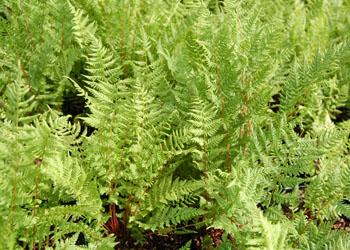General Description
Bloom Description: No flowers, the fiddleheads are extremely showy as they emerge as a deep cabernet red.
Growth Habit & Shape: A mid-sized, vase shaped fern that grows well in a variety of locations. It readily forms colonies in the shade garden. It makes a stunning specimen in the garden because of the red stems and fine texture.
Soil Preferences: Floodplain (river or stream floodplains), forest edges, forests, swamps, woodlands.
Root Description: The roots are an upright rhizome meaning they form individual vase-shaped plants in colonies.
Garden Uses: Shade garden, woodlands, woodland edge, moist woodland, pond edge garden
Best Management & Maintenance: Athyrium angustum is an easy to grow species, tolerating dappled shade to sun and various moisture levels. In sunnier spots it prefers moister soils. The root system of ferns is close to the surface so avoid trampling. This fern readily forms masses of individuals, sometimes fairly close together.
Common Problems: None. Can go dormant in the summer in sunnier/drier locations.
Benefits
Ornamental Value: Fine texture and loose colonies make this a great addition to the garden. This species blends in with numerous plants and is a good accent plant for the garden. The red stems are very showy.
Wildlife Benefits:
Other Practical/Environmental Benefits:
Use in place of: Japanese painted fern
Ecology
Habitat:
Floodplain (river or stream floodplains), forest edges, forests, swamps, woodlands
Response to Disturbance: This species is tolerant of a wide range of conditions and it will handle disturbance more readily than fern species that are typically found in deep woods settings. Does not respond well to trampling.
Native State Distributions:
Canada: Greenland; Man., N.B., Nfld., N.S., Ont., P.E.I., Que., Sask.
USA: CT, DE, IL, IN, IA, ME, MD, MA, MI, MN, MO, NE, NH, NJ, NY, NC, ND, OH, PA, RI, SD, VT, VA, WV, WI
Wetland indicator status: FAC
Companion Plants:
Trillium sp., Hexastylis shuttleworthii, Tiarella cordifolia, Chrysogonum virginianum, Sanguinaria canadensis
References
Return to Top

